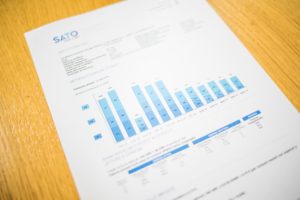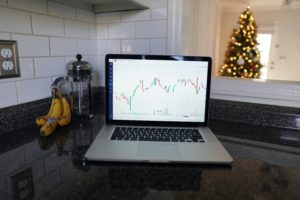This page contains affiliate links. This means that we may earn a commission if/when you click on or make purchases via affiliate links.
Foreword
Do you know what the common patterns and indicators that traders use nowadays are? Understanding and using these common patterns and indicators is essential when predicting what others will do. In previous articles, we have gone through how to draw a support and resistance line. That forms the basis of this article. If you didn’t read the article, be sure to check it out. In this article, I will walk you through some common patterns and indicators in trading.
Chart, pattern and indicator source: Finviz.com
Common Patterns
Traders or investors often spot and interpret trends, breakouts, and trend reversal based on various chart compositions (patterns). Nowadays, there is a multitude of patterns out there, used by different traders. However, some of them are not frequently seen. Therefore, I will just include some common ones in this part.
(I will include more patterns for day-trading in later articles)
Double top/ Multi-Top

A double/multi-top pattern forms when the stock price bounces at the resistance at least twice. The stock price becomes bearish when this pattern pops up in a chart.
Often, when long buyers see this pattern on the graph, they will sell their shares when the stock price is about to reach the crest. On the contrary, when short sellers see this pattern on the graph, they will place sell orders to create a selling pressure when the stock price is about to teach the crest.
As a result of both long buyers and short sellers placing sell orders when the price is about to reach the crest, the resistance forms at that price level are usually hard to be broken.
Double Bottom/ Multi Bottom

A double/multi-bottom pattern forms when the stock price bounces at the support at least twice. The stock price becomes bullish when this pattern pops up in a chart.
Often, when long buyers see this pattern on the graph, they will buy shares when the stock price is about to reach the trough. On the contrary, when short sellers see this pattern on the chart, they will cover their orders which creates a buying pressure (short squeeze) when the stock price is about to teach the trough.
As a result of both long buyers and short sellers placing buy orders when the price is about to reach the trough, the support forms at that price level are usually strong.
Ascending Triangle

An ascending triangle pattern forms when the rise of the stock price is rejected at a resistance multiple times. Meanwhile, buyers are not giving up and would like to push the price higher. The stock price becomes bullish when this pattern pops up in the chart.
Often, when long buyers see this pattern on the graph, they will place buy orders after the stock price breaks the overhead resistance. On the contrary, when short sellers see this pattern on the chart, they will place cover orders after the stock price breaks the overhead resistance.
As a result of both long buyers and short sellers placing buy orders, when the price breaks the resistance, the price usually goes higher after the resistance is broken. However, if the resistance still holds and buyers have lost their interest to push up the price, a multi-top pattern forms.
Descending Triangle

A descending triangle pattern forms when the drop of the stock price is rejected at a support multiple times. Meanwhile, sellers are not giving up and would like to push the price lower. The stock price becomes bearish when this pattern pops up in the chart.
Often, when long buyers see this pattern on the graph, they will send sell orders after the stock price breaks the support. On the contrary, when short sellers see this pattern on the chart, they will send sell orders after the stock price breaks the support.
As a result of both long buyers and short sellers placing sell orders, when the price breaks the support, the price usually goes lower after the resistance is broken. However, if the support still holds and sellers have lost their interest to push low the price, a multi-bottom pattern forms.
Wedge

A wedge pattern forms when the stock price bounces at support and resistance multiple times. Meanwhile, buyers and sellers are not giving up and would like to push the price higher and lower. The trend becomes unpredictable in such a case.
Often, when traders/investors see this pattern on the graph, they will place buy/sell orders after the stock price breaks the resistance/support.
Same as the ascending and descending triangle patterns, the price usually goes higher if the resistance breaks. While the price usually goes lower if the support breaks.
You can check stocks with these patterns on Finviz.com
Indicators
Indicators are tools that allow people to visualize data easily. They make complicated things into a simpler form by using functions. Same as pattern, there is a multitude of indicators out there, used by different traders. However, some of them are not frequently seen. Therefore, I will just include some common ones in this part.
(You are not required to know how these indicators works. All you need to know is what data they could give you)
Simple Moving Average (MA)

The simple moving average is an indicator that shows the security‘s average price of the previous ___ candles. Often, traders/ investors use this indicator to determine they are buying/selling the stocks or not. The farther the moving average and the current price, the fewer the buyers, vice versa.
Usually, when long buyers see the moving average of the shares is far from the current price, they will not buy the stocks. On the contrary, when short sellers see the moving average is far from the current price, they will try to short the stocks.
Exponential Moving Average (EMA)

The exponential moving average is an indicator that shows the security‘s average price of the previous ___ candles after they are put into a specific function. Same as the moving average, often, traders/ investors use this indicator to determine they are buying/selling the stocks or not. The farther the moving average and the current price, the fewer the buyers, vice versa.
Usually, when long buyers see the moving average of the shares is far from the current price, they will not buy the stocks. On the contrary, when short sellers see the moving average is far from the current price, they will try to short the stocks.
Actual True Range (ATR)

Actual True Range is an indicator that told traders and investors how volatile that security could be. The statistic often is derived from the 14-day simple moving average.
If you are searching for stocks with high risk and high reward, you could find stocks with this index at a high level, vice versa.
Volume

Volume is an important indicator that records the number of trades that went through in a timeframe. Often, traders and investors would validate breakouts with volume. If the volume is lower when compared to other times, the breakout is likely to be a fakeout.
(I will explain more about how to use it in later articles)
Related article: What is Volume and how to use it?
Volume Weighted Average Price (VWAP)

The Volume Weighted Average Price (VWAP) is an indicator that shows the average price of security throughout a timeframe based on both price and volume. Often, traders and investors would use this indicator as a trend confirmation tool. They will buy/short stocks when they see the stock price is higher/lower than the VWAP.
Relative Volume

Relative Volume is an indicator that compares the current trading volume and the average trading volume over a given period – usually five days, 30 days, or 60 days. Often, traders will use this indicator to see whether a stock (or security) is hot or not. If the Relative Volume of a stock is tremendous, traders will then look at the stock and further buy the stock.
Final Thought
In this article, we have gone through several common patterns and indicators that traders use nowadays. Although it may take you plenty of time and effort to learn how to spot and take advantage of these patterns and indicators, it is worth it. Hope you find this article helpful.
[Next Lesson: Technical Analysis: How to use Volume in 4 simple ways]





